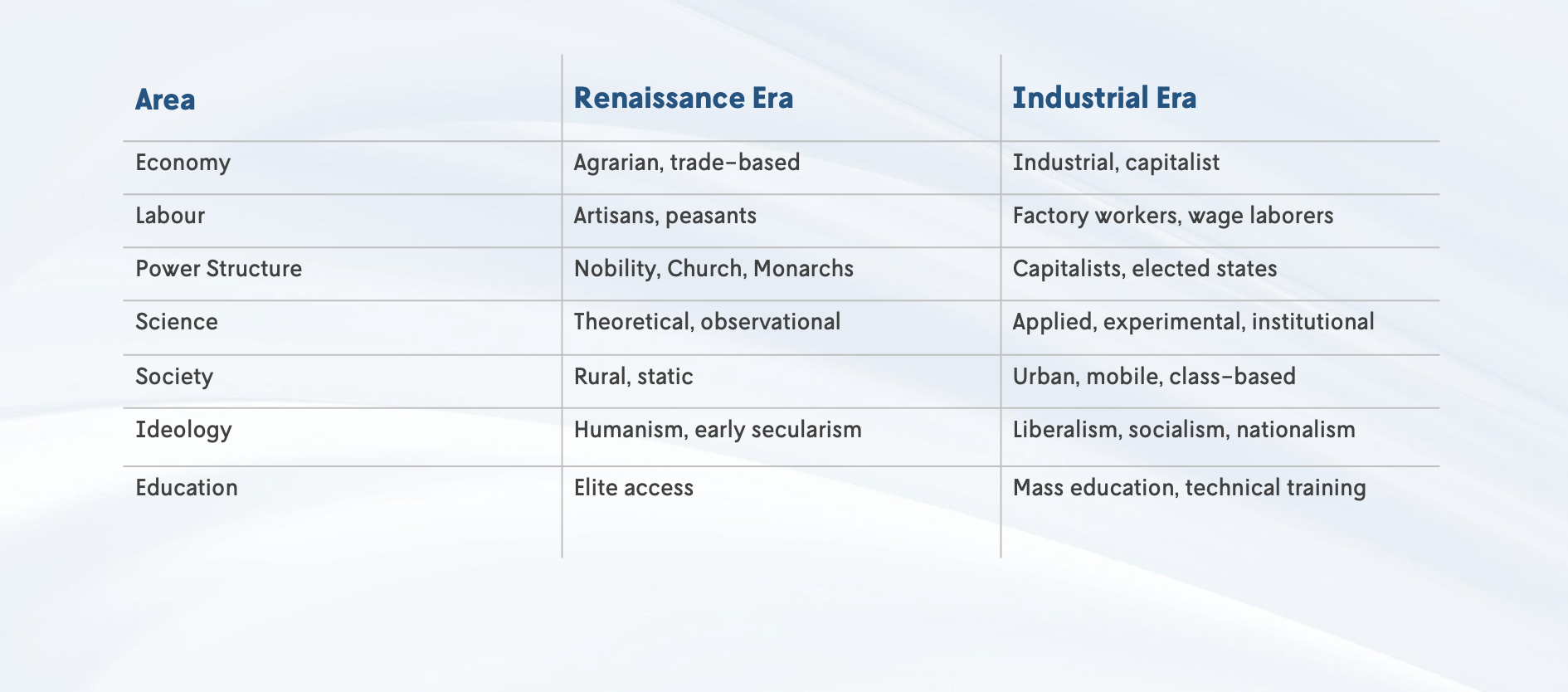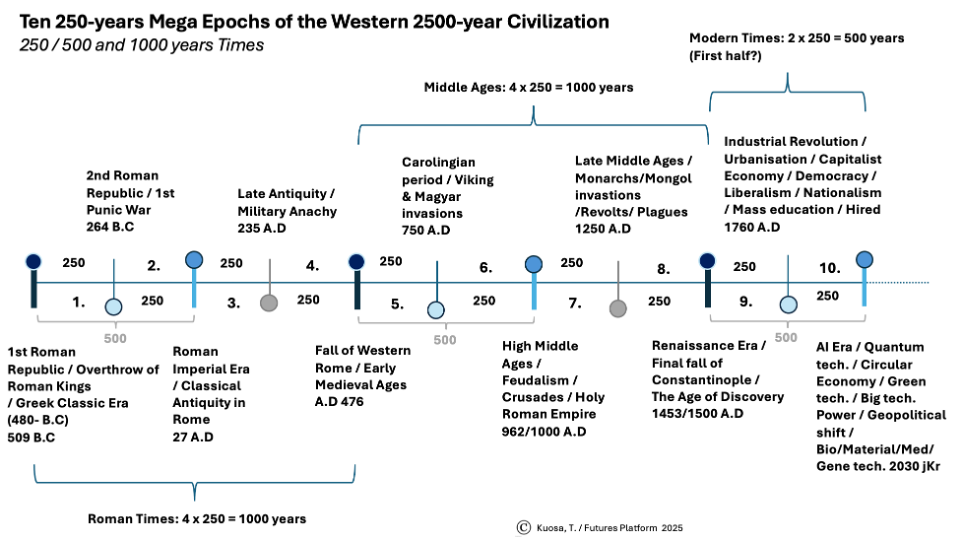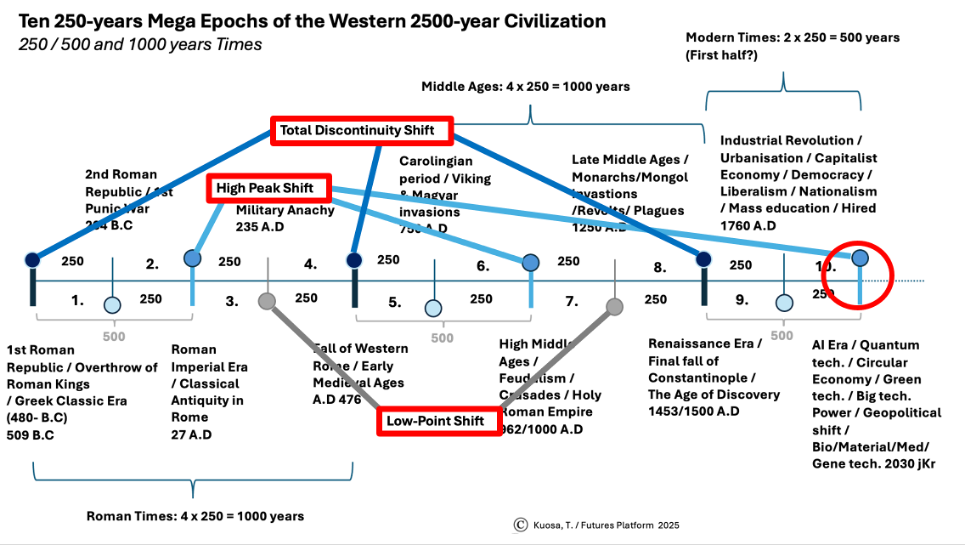250-Year Civilisational Mega Epochs and Thousand-Year Ages
Roughly every 250 years, human civilisation undergoes a dramatic reset. They are moments where kingdoms rise and fall, economies shift, values are rewritten, and societies reorganise themselves at every level — political, economic, cultural, even existential. These aren’t ordinary historical moments but mega epochs, when all shorter societal cycles align and force civilisation onto a new path.
Epoch Change blog series, No. 7
Dr. Tuomo Kuosa
Tuomo is co-founder and Director of Futures Research at Futures Platform. He holds a PhD from the Turku School of Economics and is an Associate Professor (Docent) of Strategic Foresight at the Finnish National Defence University.
FUTURE PROOF – BLOG BY FUTURES PLATFORM
Across macrohistorical analysis literature, scholars have identified five recurring cycles of transformation: some as short as a decade, others stretching over a century. Each plays a distinct role in world history, and each has its own rhythm and logic, which can be explained via unique retroaction models.
But in the course of my own research, I came across a much larger and often overlooked pattern: Mega Epochs of roughly 250 years. These longer epochs are composed of two or more shorter cycles, and at their turning points, all smaller rhythms converge and synchronise. The result is nothing less than a civilisational reset.
The Five Recurring Cycles of Societal Transformation
Macrohistorical research identifies five broad cycles of change:
Nano cycles (≈7-12 years)
Micro cycles (15–30 years)
Mid cycles (40–60 years)
Meta cycles (70–100 years)
Macro cycles (100–130 years)
All these cycles co-exist and influence each other, meaning that they co-evolve. And every 250 years, there comes a decisive moment in world history where all five of these shorter cycles synchronise. At such junctures, history takes a decisive new direction. These moments are larger than wars or power transitions alone. They are moments where societies reorganise themselves at every level — political, economic, cultural, even existential.
Mega Epochs: When All Cycles Converge
A Mega Epoch can be thought of as a package of shorter cycles that together span roughly 250 years: ten Micro cycles, five Mid cycles, or combinations of Meta and Macro cycles.
The last great shift of this kind was the transition from the Renaissance to the Industrial Era in the mid-18th century. This shift was so profound that not only did all aspects of society, power dynamics, and structures change, but also the very fundamental values, economic principles, and even the concept of what it means to be human in society underwent significant transformation.
Arguably, the upheavals of World War I and II, vast as they were, pale in comparison — mid-epoch disruptions rather than full resets. These mid-epoch turmoils of WW1 and WW2 ended the age of grand empires and colonialism, paving the way for nation-states, international organisations, and a rules-based order. The British Empire's hegemony was shifted to the United States and to its new rival, the Soviet Union.
But the shift to industrial modernity was deeper still: it introduced capitalism, democracy, urbanisation, mass education, and the clock as a new regulator of daily life.
Ten Mega Epochs of Western Civilisation
One way to date Western civilisation is to say that its first embryo was born with the Roman Republic in 509 BCE. If we take that as a starting point and stretch our view to the present, we arrive at a span of roughly 2,500 years. Divided into 250-year units, that gives us about ten Mega Epochs in total.
These epochs cluster into larger thousand-year Ages: the Roman Times, the Medieval Ages, and the Modern Times. Each Age unfolds through four Mega Epochs, with a High Peak Shift in the middle and a Total Discontinuity Shift at the end.
Classic & Roman Times (500 BC – 500 AD)
Roman Republic / Greek Classic Era: 480/509 BC: – 27 BC = 2 x 250 years
Total Discontinuity Shift at the beginning of Western Civilisation: Prehistory ends, Greek Classic Era begins, and the overthrow of Roman Kings.
1st epoch: First Roman Republic: 509 BC – 1st Punic War 264 BC
Shift at the End: Rome’s victory over Carthage. Rome became a leading military power in the Mediterranean.
2nd epoch: Second Republic: 1st Punic War 264 BC – 1st emperor Augustus 27 BC
High Peak Shift at the End: In 27 BC, the Roman Empire with military and economic hegemony established, and Classical Antiquity in Rome begins.
Roman Imperial Era: 27 BC – 476 AD = 2 x 250 years
3rd epoch: Roman Imperial Era: 1st emperor Augustus 27 BC – Crisis of the 3rd century / military anarchy 235 AD
Low-Point Shift at the End of Third Epoch: Civil wars, foreign invasions, economic hardship, and a near collapse of the Empire.
4th epoch: Late Antiquity: Crisis of the 3rd century / military anarchy 235 AD – Fall of Western Rome 476 AD
This 4th Epoch marks the end of 1000 years of Roman Times and the beginning of the Early Medieval AgesTotal Discontinuity Shift at the End: In 476 AD, the collapse of Roman rule and any centralised authority led to counterurbanization, population decline, invasions, and mass migrations of tribes.
Image 1: Ten Mega Epochs
Medieval Ages (500 – 1500 AD)
Early Medieval Ages: 500 – 1000 = 2 x 250 years
1st epoch: Very Early Middle Ages: Fall of Western Rome 476 – Viking & Magyar invasions, Carolingian period 750
Shift at the End: The Carolingian dynasty began; Charlemagne crowned as the first Emperor of the Romans in the West.
2nd epoch: Early Middle Ages: Viking & Magyar invasions, Carolingian period 750 – Feudalism / Holy Roman Empire 962
High Peak Shift at the End: Holy Roman Empire established in 962; Otto I defeats the Magyars & end of invasions; fall of the Caliphate of Córdoba; Christianity becomes ideological unifier of Europe; Crusades; population grew from 35 to 80 million; economic growth & urbanisation; hierarchical societal structure (land owners, peasants, serfs and dues) consolidated.
High and Late Medieval Ages: 1000-1500 = 2 x 250 years
3rd epoch: High Middle Ages: Feudalism / Holy Roman Empire 962 – Monarchs / Mongols / Revolts / Plagues 1250
Low-Point Shift at the End of Third Epoch: Plagues, famine, economic hardship, wars, revolts & foreign (Mongol) invasions led to a diminished population. Labour shortages upended the manorial economy, marking the decline of Feudalism and the rise of local monarchs with centralised power.
4th epoch: Late Middle Ages: Monarchs / Mongols / Revolts / Plagues 1250 – Final fall of Constantinople 1453 / Age of Discovery, Columbus voyages across the Atlantic 1492–1504
This 4th Epoch marks the end of the 1000-year Medieval Ages and the beginning of Modern Times.Total Discontinuity Shift at the End: Previously isolated parts of the world became connected to form the present-day world-system, laying the groundwork for globalisation. This period saw explorations and colonisation of the Americas, greater social unrest, and a questioning of feudal, noble, and religious authority. It also saw the rise of humanism, the Enlightenment, and significant scientific discoveries.
Modern Times (1500 – 2500)
Renaissance Era: 1500 – 1760 = ca. 250 years
1st epoch: Final fall of Constantinople 1453 / Age of Discovery, Columbus 1492–1504 – Industrial Revolution 1760
Shift at the End: The beginning of industrialisation and democracy; urbanisation; capitalist economy; liberalism; nationalism; mass education; hired employees; clock & measuring hours.
Industrial Era: 1780 – 2030 = 250 years
2nd epoch: Industrial Revolution 1760 – AI Revolution 2030
High Peak Shift: Ubiquitous AI, quantum computing, green transition & circular economy, health/medical/gene & biotech/material revolution, geopolitical shift; rule-based world & nation states lose power to oligarchs and corporations.
A Pattern Through History
As past civilisational Mega Epoch changes show, they tend to come in packages of four 250-year epochs. These combine into two pairs of 500-year packages, which form what can be called a “Time” or “Age” — four Mega Epochs in total.
For example, the Roman Republic and the Roman Empire eras each lasted about 500 years, together forming the thousand-year “Roman Times.” The high-peak shift came midway, with the rise of the Empire, while the low-point shift came at the end of the 3rd Mega Epoch. Finally, the 4th Mega Epoch total discontinuity shift — the fall of Western Rome — brought the entire Age to an end.
The same rhythm can be seen in the Medieval Ages. Two early epochs were followed by the high-peak shift of the Medieval Ages, the High Middle Ages. Then the low-point shift came at the end of the 3rd Mega Epoch: the Late Middle Ages. The final, fourth Epoch ended in a total discontinuity shift — the collapse of religious, noble and feudal authority, alongside the rise of new ideas of humanism, exploration, enlightenment and scientific discovery.
By contrast, the Modern Times have so far lasted only 500 years — composed of the two 250-year Mega Epochs of the Renaissance and the Industrial Era.
Image 2: High Peaks, Low Points and Total Discontinuities through history
Where we stand today
By this logic, the Modern Times is approaching its 500-year boundary. And today, we may be approaching another high-peak shift: the rise of artificial intelligence, which has real potential to mark a pivotal turning point in human history.
If history follows the same pattern, Modern Times could also consist of four Mega Epochs, two of which are now nearly complete. It’s plausible to assume that the next pair, beginning around 2030 and stretching over the coming centuries, will most likely be AI-centric — but with new twists and topics emerging in the years to come. Looking at the bigger picture, the next mega epochs may involve an AI industrial age, a post-humanist era, singularity, or even one shaped by virtuality, space exploration, or universal connectivity. There are many ways in which the next 500 years of the Modern Times could unfold.
So how might the next two epochs of the current Age unfold, if this pattern holds? Below is a speculative timeline:
Late Modern Times: (2000 – 2500 CE = 2 × 250 years)
3rd epoch: Singularity Era: AI Revolution 2000/2030 – e.g Post or trans-humanistic turn 2250.
If the previous patterns hold, the AI Revolution that is emerging now is the next High Peak, and the Post or trans-humanistic turn at the End of Third Epoch is going to be the next Low-Point Shift of Modern Times.
4th epoch: Space Travel Era: e.g Post or trans-humanistic turn 2250 – e.g Universal connectivity's and cosmic wisdom's turn 2500
Total Discontinuity shift: At the end of fourth epoch — the end of Modern Times and the eginning of new times in human history.
If history is any guide, our civilisation may be on the cusp of another epochal reset right now. The coming decades could be remembered not merely for technological change, but as the moment humanity stepped into its next 500-year arc — composed of the two 250-year mega epochs. Whether that future is AI-dominated, post-human, or a space age, the rhythm of history suggests one thing with certainty: the next reset is coming, and it may lead us to a new High Peak of Modern Times.
This article is the seventh instalment in Dr. Tuomo Kuosa’s Epoch Change series. You can find the other articles in this series listed below:
The Shift in Technological Platforms and Business Ecosystems Over Time
From Chaos to Order: What Nature Can Teach Us About Societal Change
Are there five, six or even more different lengths of societal cycles?
250-Year Civilisational Mega Epochs and Thousand-Year Ages







